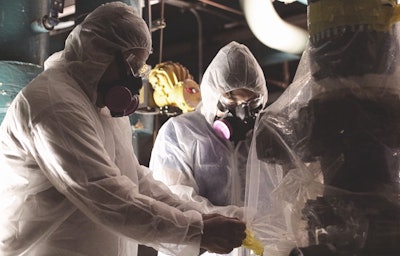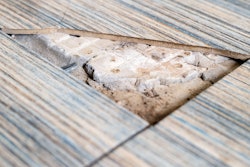
Information from this article was first published in Demolition Magazine and is being reused with permission from the National Demolition Association.
By Sue Rose
 View of the 157 Vought Aircraft plant buildings scheduled for abatement and demolition.1 Priority Environmental Services
View of the 157 Vought Aircraft plant buildings scheduled for abatement and demolition.1 Priority Environmental Services
Vought occupied the aircraft plant near Dallas from 1940-2012. According to 1 Priority CEO Gary Caldwell, “The site, now called Dallas Global Industrial Center, was first built for armament construction for World War II.”
The plant was home to the construction of the historic and contemporary military planes such as the B-1 bomber, F-22 Raptor, and parts for commercial aircraft such as the Boeing 747 and 777 over the course of its 72-year stay. At its prime, the plant employed over 29,000 people.
“Although this is our first collaboration with Northpoint Development, 1 Priority and its owners have performed asbestos abatement, mold remediation and hazardous dust decontamination work at this facility since the early 1990s when it was owned by LTV, Vought Aircraft and Triumph Aircraft,” Caldwell says. “Our record of work here made this massive abatement project a natural progression.”
1 Priority has currently abated the asbestos from 83 of the 157 buildings on the campus and is slated to abate the balance before the end of 2020.
According to Heath Watson, executive vice president of field operations for 1 Priority, current abatement work includes the removal of asbestos-containing materials from up to 157 buildings that were previously used for offices, manufacturing, storage and hangars.
 Highly skilled Priority 1 asbestos abatement technicians performed “glove-bag” abatement of insulated piping within the manufacturing buildings scattered across the property.1 Priority Environmental Services
Highly skilled Priority 1 asbestos abatement technicians performed “glove-bag” abatement of insulated piping within the manufacturing buildings scattered across the property.1 Priority Environmental Services
Safety is a top priority
“Because this is an industrial site, there are additional safety measures we follow explicitly,” Watson says. “Our crews are always wearing personal protective equipment (PPE) comprised of disposable Tyvek suits and respirators with the appropriate filtration based on the materials being abated.”
Other safety and protective equipment required for this project include fall protection harnesses with retractable lanyards, high-visibility vests, hard hats, steel toe boots, hearing and hand and eye safety devices. The engineering controls necessary for the containment of asbestos debris needed differ based on the type of materials being abated and their use within each building. For example, water piping covered with asbestos insulation is contained and abated inside glove bags.
Boiler insulation, fireproofing, large areas of walls, ceilings and flooring need to be abated inside full, negative pressure containments, which include multiple layers of poly sheeting on all interior, and sometimes exterior, building surfaces. For this type of work, an even higher level of respiratory protection equipment is required for employees. In addition, each time employees exit these full containments, they are required to shower out through a three-stage wet decontamination chamber.
Asbestos abatement progresses successfully
1 Priority workers assisted contractors in removing asbestos from 132 of the 157 buildings on the property in a timely and efficient matter.
 In addition to the flooring, fireproofing, walls and ceilings that required abatement within the interior of the buildings, thousands of feet in asbestos-insulated piping was removed from tunnels and pipe racks that connected each building.1 Priority Environmental Services
In addition to the flooring, fireproofing, walls and ceilings that required abatement within the interior of the buildings, thousands of feet in asbestos-insulated piping was removed from tunnels and pipe racks that connected each building.1 Priority Environmental Services
Critical delays were also avoided thanks to the flexibility of 1 Priority when the Texas Asbestos Health Protection Rules (TAHPR) agency deemed that the previous owner’s testing, what was being used as the baseline for remediation efforts, was not sufficient. A 1 Priority analyzer was able to re-evaluate the buildings, and Watson and his crew were able to continue on with the National Emissions Standards for Hazardous Air Pollutants (NESHAP) compliant asbestos removal within a few days.
Sue Rose is a principal at Construction Writers Collaborative. She launched the Construction Writers Collaborative in 2016 to deliver spot-on content for the AEC sector in Colorado and beyond. She has run Rose Public Relations since 2001.



















